Basal Ganglia
1/65
There's no tags or description
Looks like no tags are added yet.
Name | Mastery | Learn | Test | Matching | Spaced |
|---|
No study sessions yet.
66 Terms
basal ganglia, association cortices, thalamus, and the cerebellum are all parts of the ___ system
extrapyramidal
what nuclei form the striatum?
caudate and putamen
what nuclei form the lenticular nucleus?
putamen and globus pallidus
what are the three dopamine pathways?
mesostriatal, mesolimbic, and mesocortical
The dopamine pathway involving the putamen and the caudate is called the
mesostriatal pathway
the dopamine pathway associated with the nucleus accumbens, cingulate cortex, amygdala, medial orbital frontal cortex, and the hippocampus is called the
mesolimbic pathway
the dopamine pathway associated with the prefrontal cortex is called the
mesocortical pathway
___ structures are involved in the attentional and motivational aspects of motor control
basal ganglia
generally, damage to basal ganglia structures causes:
impairment to movement without paralysis. too much or too little movement, tremor, involuntary movements, etc
the basal ganglia structures function primarily through (excitation/inhibition)
inhibition
the basal ganglia connects with ___ but has no direct inputs from ___ or direct outputs to ___
the basal ganglia connects with motor areas of cortex but has no direct inputs from periphery or direct outputs to spinal motor circuits
proper motor control requires a balance between the ___ and ___
indirect and direct pathways
cortical inputs into the basal ganglia are (inhibitory/excitatory)
excitatory

cortical outputs from the basal ganglia are mediated through the ___
thalamus
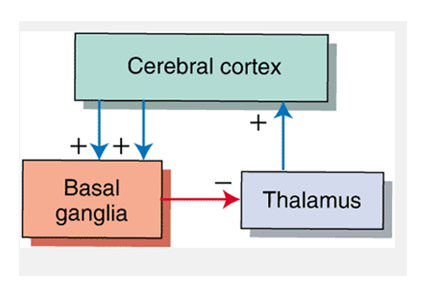
inputs to the thalamus from the basal ganglia are (excitatory/inhibitory). why?
inhibitory, because thalamic outputs to the cortex are normally excitatory
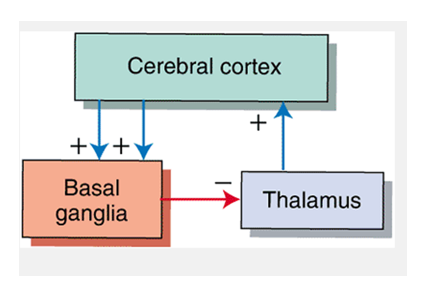
describe the differences between the caudate and the putamen (inputs, functions)
inputs: the putamen receives inputs from primary motor, secondary motor, and primary somatosensory cortex. the caudate receives inputs from cortical association regions, frontal eye fields, and limbic cortex.
functions: putamen has primarily motor function, caudate is associated with cognitive aspects of movement, eye movements, and emotional correlates of movement

___ are the main cell type of the striatum
medium spiny neurons
the subthalamic nucleus has inputs from ___ and outputs to ___
external globus pallidus, internal globus pallidus
the cerebral cortex projects to the brainstem and spinal cord via the ___ tract and ___ projections
corticospinal tract and corticobulbar projections
cerebral cortex to striatum: what kind of projections? what neurotransmitters?
excitatory projections to D1 and D2 neurons in the striatum. glutamate
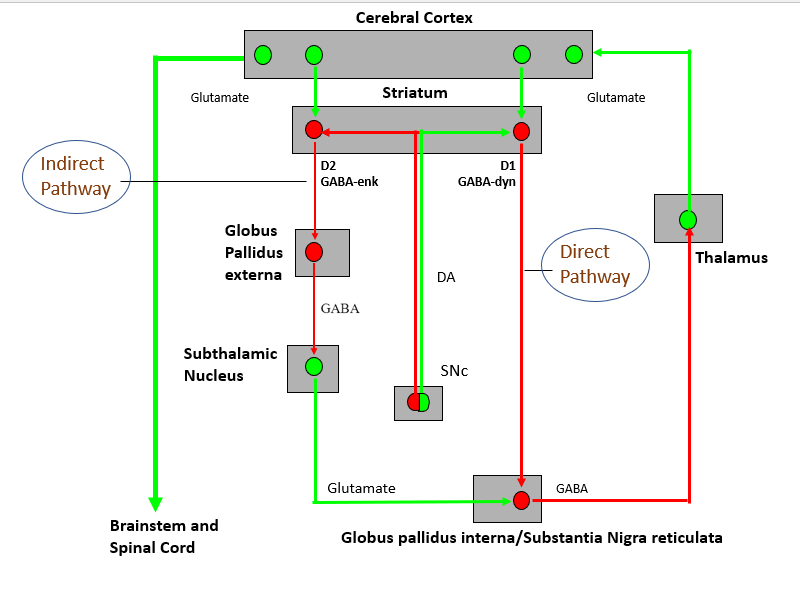
where do D1 and D2 neurons in the striatum get their inputs from?
excitatory (Glu) projections from the cortex and mixed projections from the substantia nigra (DA)
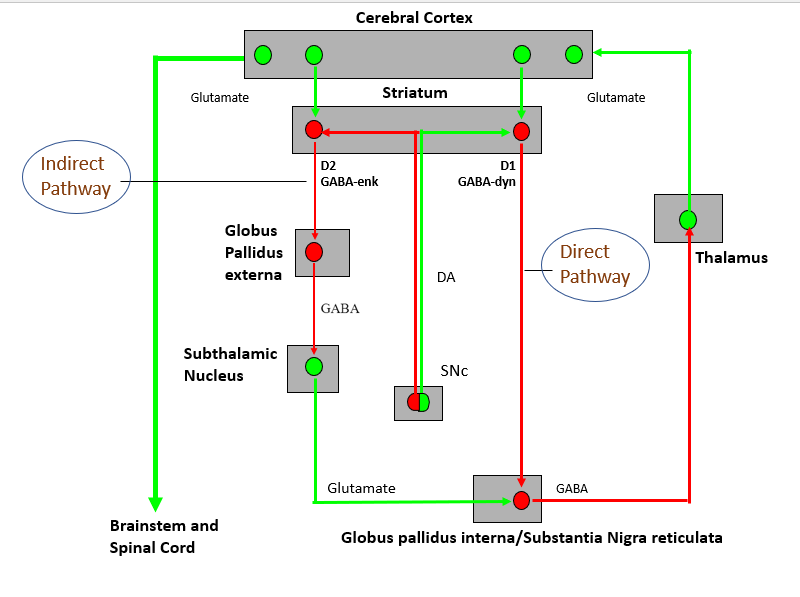
in the striatum, D1 neurons see dopamine as ___ and send ___ projections to the GPi/SNr. D2 neurons see dopamine as ___ and send ___ projections to the GPe.
D1 - excitatory, sends inhibitory projection to GPi and SNr
D2 - inhibitory, sends inhibitory projection to GPe
(both have inhibitory projections)
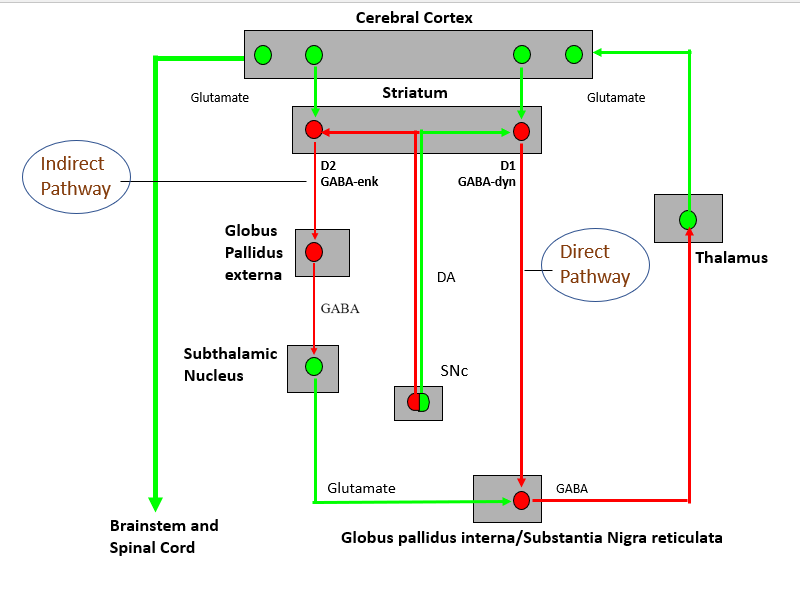
the globus pallidus interna/SNr receive input from ___ and send output to ___
D1 neurons in the striatum, thalamus
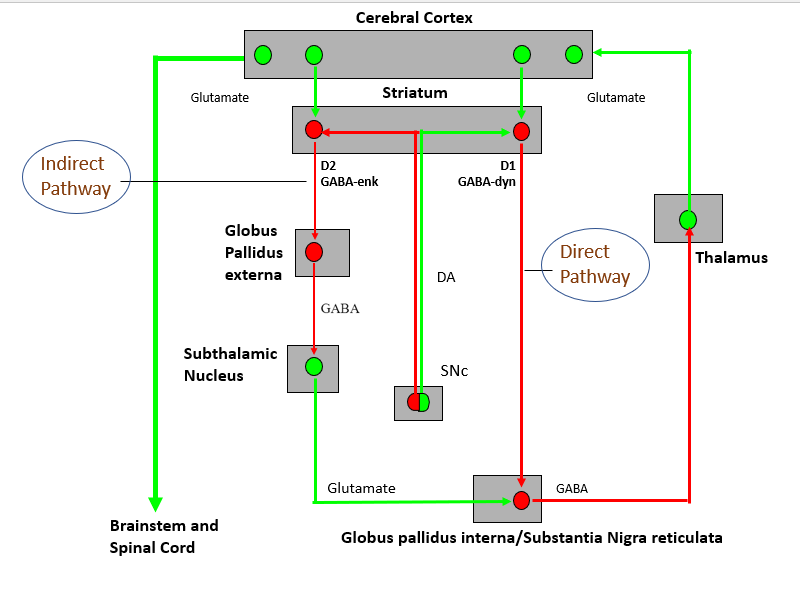
the globus pallidus externa receives input from ___ and sends output to ___
D2 neurons in the striatum, subthalamic nucleus
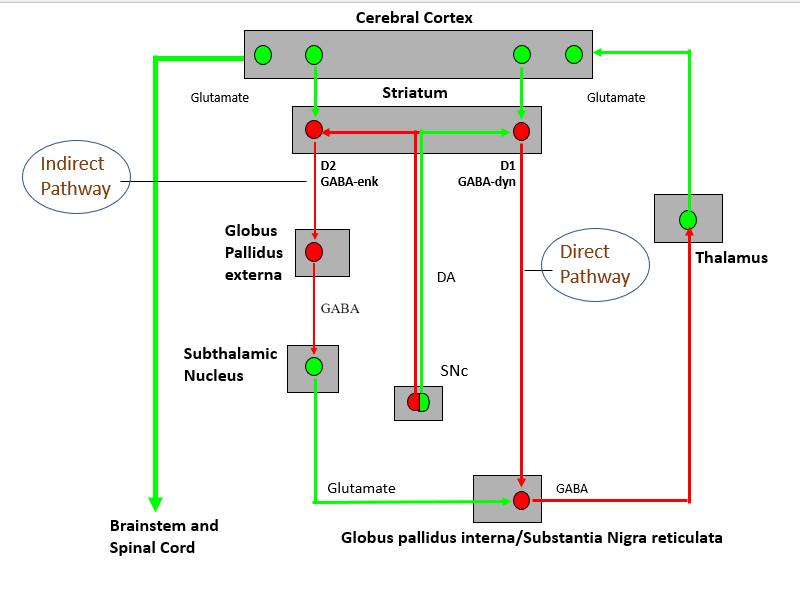
D1 and D2 neurons release which neurotransmitters?
GABA (different versions but don’t need to know that for this test)

the globus pallidus externa (excites/inhibits) the subthalamic nucleus, which (excites/inhibits) the globus pallidus interna/SNr
inhibits, excites
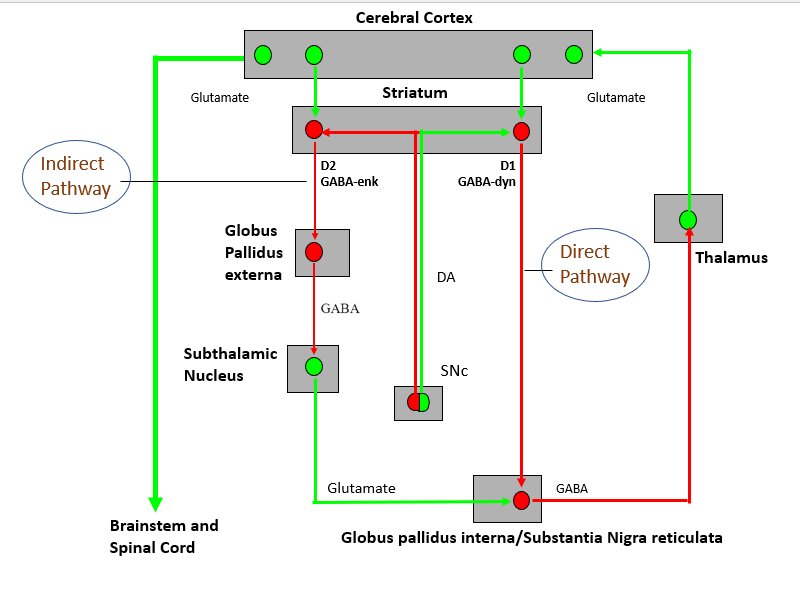
when the globus pallidus interna is excited, it (excites/inhibits) the thalamus, which then (excites/inhibits) the cortex
inhibits, excites

describe the direct pathway
excitatory inputs from the cerebral cortex (Glu) and excitatory inputs from SNc (DA) → D1 in striatum
D1 neurons inhibit GPi/SNr, which reduces the inhibition on the thalamus (GABA).
Thalamus increases the excitation to cortex
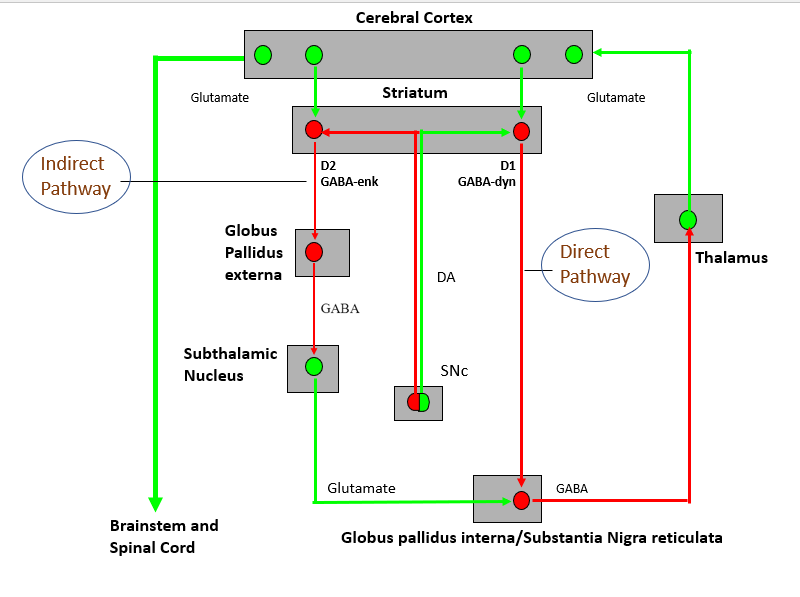
describe the indirect pathway
excitatory inputs from the cerebral cortex (Glu) and inhibitory inputs from SNc (DA) → D2 in striatum
D2 neurons inhibit the neurons of GPe (GABA), which then inhibits neurons of the subthalamic nucleus (GABA)
then, the subthalamic nucleus excites the GPi (Glu), which then increases the inhibition on the thalamus (GABA).
thalamus now sends less excitatory projection to cortex
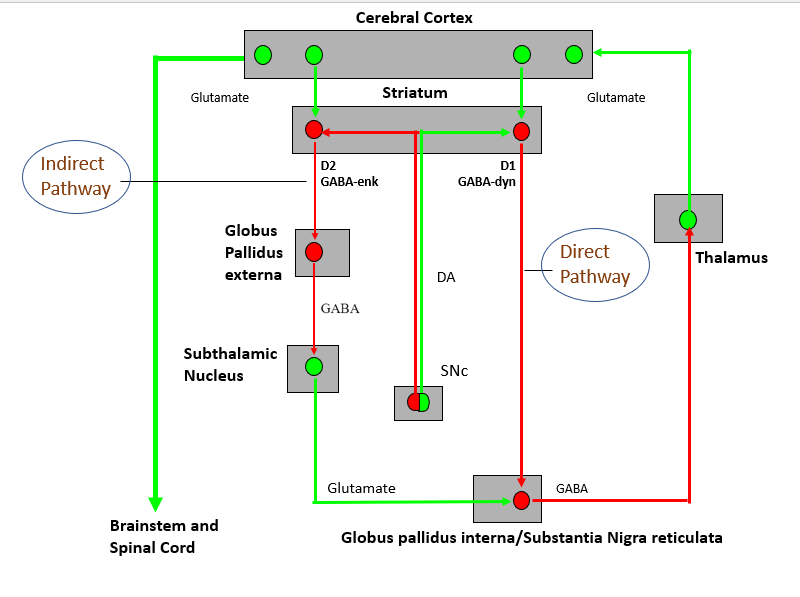
alterations in the non-motor loop of the basal ganglia cause cognitive and emotional deficits of ___
parkinson’s and huntington’s diseases
what are the 5 functional channels of the basal ganglia?
oculomotor, motor, prefrontal, limbic, and anterior cingulate cortex to ventral striatum
which functional channel is associated with the putamen and the caudate tail?
the motor channel
which functional channel is associated with VA and MD?
oculomotor channel
which functional channel is associated with the caudate head?
prefrontal channel
what is parkinsonism?
akinesia or rest tremor with rigidity and postural reflex deficits
is parkinsonism an example of hypokinesia or hyperkinesia?
hypokinesia
twisting, sustained abnormal posture
dystonia
involuntary rapid irregular movements
chorea
shock-like movements of face, neck, and voice
tics
rhythmic to-and-fro oscillation around a joint
tremor
what are the abnormal neural functions behind parkinson’s disease?
less direct path inhibition of GPi and more indirect path facilitation of GPi. this then keeps the thalamus inhibited. little movement can occur
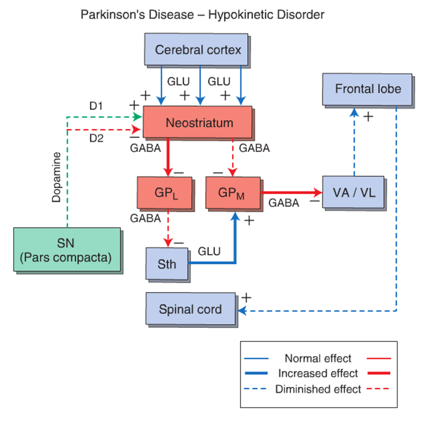
in parkinson’s disease, the “brake” is uninhibited. what is the brake?
basal ganglia
huntington’s disease is associated with
less indirect path facilitation of GPi. then the output from the GPe is less inhibited, and the thalamus can be more excitatory. leads to involuntary movements
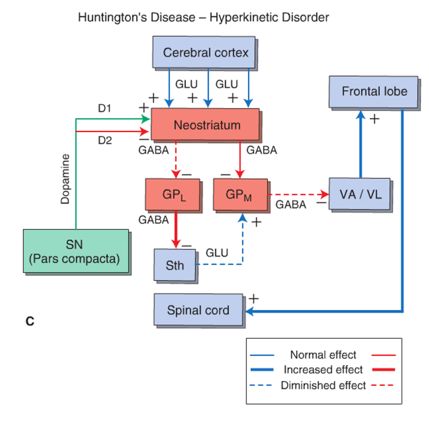
huntington’s vs parkinson’s
huntington’s - involuntary movements (failure to suppress). intention tremor.
parkinson’s - movement difficulty (failure to initiate). resting tremor.
loss of medium spiny GABAergic neurons in caudate. due to loss of inhibitory feedback loops, ability to fine-tune movement is lost and severe intention tremor during movement.
Huntington
what is hemiballismus?
large repetitive movements on one side of the body resulting from subthalamic nucleus injury (less excitation of GPi, less inhibition of thalamus, more excitation of cortex)

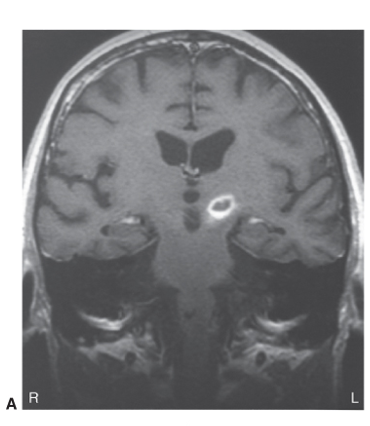
where is the injury, what is the result
subthalamic nucleus, hemiballismus
what plans movement?
cortical association areas and dorsolateral PFC
what initiates postural movement?
basal ganglia
what refines movement?
lateral cerebellum
what executes movement command?
premotor and motor cortex
what tract(s) is/are included in the pyramidal system?
corticospinal
what tract(s) is/are included in the extrapyramidal system?
rubrospinal, reticulospinal, tectospinal, vestibulospinal
what are the general steps in the motor pathway functional timeline?
planning and programming
execution
monitoring
feedback
what area(s) is/are associated with the vestibulospinal tract?
lateral and medial vestibular nuclei

what area(s) is/are associated with the reticulospinal tract?
pontine and medullary reticular formation
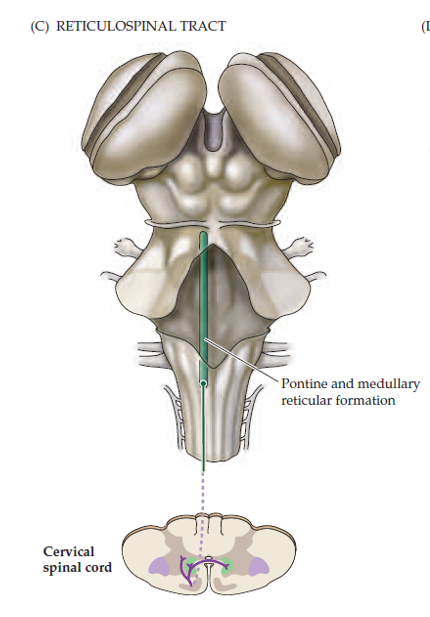
what area(s) is/are associated with the rubrospinal tract?
red nucleus
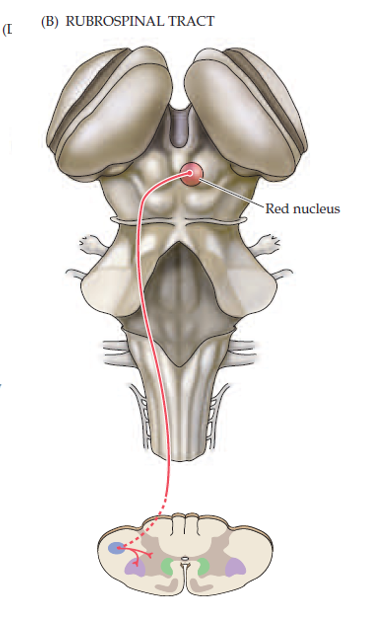
what area(s) is/are associated with the colliculospinal tract?
superior colliculus
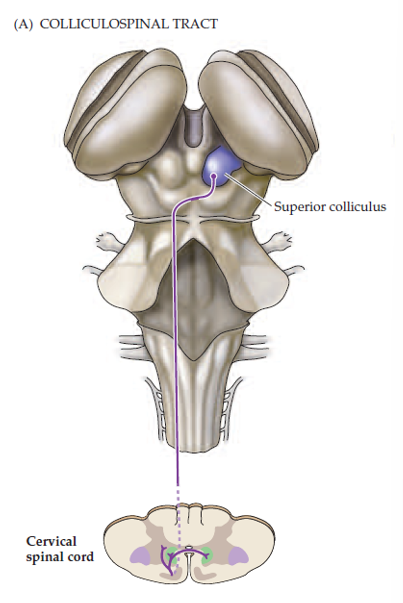
which motor path is involved with most limb flexors?
rubrospinal
which motor path is involved with mostly extensors of lower extremity and minor role in axial extensors (catching yourself for balance)
vestibulospinal
what motor path is involved with the axial muscles of the neck?
tectospinal
what motor path is involved with minor extension of upper and lower extremities and innervation of axial muscles of neck?
reticulospinal
decorticate vs decerebrate state
decorticate - loss of cortex control, but midbrain and below are intact. flexed arms (rubro) and extended legs (vestibulo)
decerebrate - midbrain lost. extended arms (reticulo), extended legs (vestibulo)
describe the motor control 3 levels of command
highest level - limbic, paralimbic, and association cortices. provides executive control of goal-directed behavior and the earliest motor plan of the movement
middle level - sensory motor cortex, basal ganglia, cerebellum, and motor nuclei. converts motor plans to motor programs (specific plan to perform the movement)
lowest level - motor neurons and interneurons. translate instructions for movement into commands to muscles
what is the hyperdirect pathway?
cortical activity directly to the subthalamic nucleus stops the basal ganglia from selecting a response prematurely
Which tracts allows a cat to turn and land on its feet?
tectospinal (controls the neck muscles and head turn reflex)